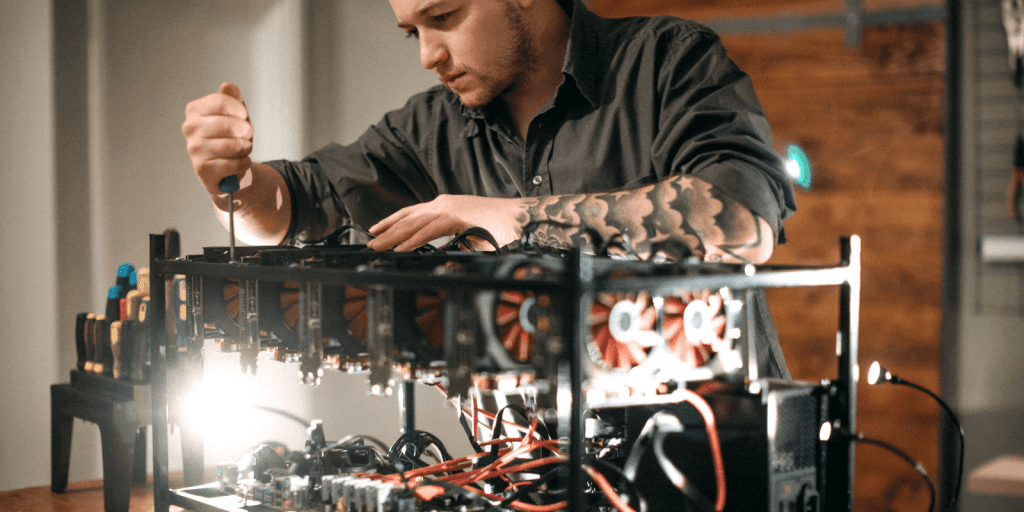Mining has been a key part of the cryptocurrency economy since its inception. In order to mine coins, participants must use computer systems to solve complex mathematical problems. This process is known as hashing. Over the years, miners have developed many different strategies for hashing, and one of the most popular methods is using graphics processing units or GPUs. GPUs are such an important tool for miners. In this blog post, we will discuss how GPUs in mining systems can be used in detail.
History of Bitcoin
History of Mining In 2009, the very first cryptocurrency – Bitcoin- was created by an enigmatic person or group of persons operating under the pseudonym Satoshi Nakamoto. This revolutionary currency is mined and produced through a process known as ‘mining’, which rewards miners with cryptocurrencies for verifying and committing transactions to the blockchain. Since then, Ethereum, Litecoin, and several other digital currencies have been developed in their wake. By today an enormous number of people sell and buy Bitcoin in Dubai and other parts of the world and it got so successful that a large number of businesses are adopting it now. Mining is composed of three fundamental aspects: verifying transactions, adding them to the blockchain, and protecting the network. To authenticate these exchanges, miners must solve a complex cryptographic puzzle with their computer’s computing power. As more people join this system, the difficulty of such a challenge increases accordingly. Anyone can participate in solving this problem provided they possess an adequately strong machine.
What are GPUs?
GPUs, or graphics processing units, were originally created to heighten the speed and visual quality of 3D video games. Nowadays though, GPUs are being utilized for a broad range of purposes because they’re much quicker at handling multiple operations than CPUs. This is why GPUs are great for cryptocurrency mining tasks, deep learning algorithms and other demanding data-intensive processes.
How does GPU help in crypto mining?
GPUs are used in cryptocurrency mining because they can perform more calculations than CPUs. GPUs have been specifically designed for graphics and gaming and can therefore handle the complex mathematical calculations needed to solve blocks and create new cryptocurrency tokens.
Who produces GPUs that can be used in crypto?
GPUs that can be used in crypto are produced by a number of companies, including Nvidia and AMD. These GPUs are specifically designed to handle the intense calculations required for mining cryptocurrency.
What is a GPU mining rig?
A GPU mining rig is a computer system used for cryptocurrency mining. GPUs are the most efficient miners on the market, and thus are better suited to mining than CPUs. Mining rigs consist of multiple GPUs connected to a motherboard that runs mining software in order to mine cryptocurrencies.
What do you need to get started with mining?
Here we mention some things:
1. The GPU foundation of a mining rig
You need a good foundation to start mining crypto, and that means having a powerful graphics card (GPU). The graphics card is essential for mining because it solves complex mathematical problems to verify cryptocurrency transactions. To get started with mining Bitcoin, Ethereum, or any other currency, you’ll need some important components: a GPU, motherboard, power supply unit (PSU), CPU, memory (RAM), storage (hard drive or SSD), and an operating system. You can find all of these items on Amazon or other online retailers. Be sure to research the best components for your budget and needs.
2. A powerful CPU
That’s not entirely true. The CPU does affect GPU performance, but not in the way you might think. When it comes to mining cryptocurrencies, the CPU is used to authenticate blocks, while the GPU is used to mine new coins. So, if you have a powerful CPU and a weak GPU, your computer will be better suited for mining cryptocurrencies than if you have a powerful GPU and a weak CPU.
3. A motherboard that is compatible with the CPU
You don’t really need a high-end motherboard to start mining cryptocurrencies. However, you should make sure that the motherboard is compatible with the CPU you buy. For instance, if you have a Ryzen processor, you’ll need a motherboard that is compatible with Ryzen processors. Similarly, if you have an Intel processor, you’ll need a motherboard that is compatible with Intel processors.
4. Hard drive
You’ll need a hard drive to store your operating system and your crypto-mining software. Hard drive requirements vary based on your operating system. For Windows, you’ll need at least 40GB of free space. For Mac, you’ll need at least 20GB of free space. And for Linux, you’ll need at least 10GB of free space.
5. Power supply unit
Cryptocurrency mining is a process by which new coins are created. To get started in cryptocurrency mining, you need a power supply unit (PSU) to provide power to your mining hardware. You also need a graphics processing unit (GPU) to mine cryptocurrencies. Finally, you need appropriate software and/or hardware to connect your GPU to the internet so that it can start mining cryptocurrencies.
6.RAM
A key factor in GPU-based crypto mining is the availability of high-speed memory. GDDR5X memory is employed in many of the latest gaming graphics cards, and it operates at a speed of 10 Gbps. You will need at least 4GB of GDDR5X memory to operate a 6-GPU rig. Another key component is your motherboard’s ability to support multiple GPUs. Make sure that your chosen motherboard has six PCI Express slots, and that all of them are connected to the CPU. Also, be sure that your power supply can handle the additional load from multiple graphics cards—most modern power supplies can easily accommodate this extra demand.
7. Cooling fans
Graphic cards generate a lot of heat, and if you’re running multiple graphics cards in a single computer, the heat can build up to the point where it can damage your computer. So you need to have good cooling in place to protect your computer from overheating. In addition, you need a reliable source of electricity. If the power goes out, your mining operation will come to a halt. And finally, you need a place to store your mined coins so that you can access them when you want to sell them.
8. Riser space
You need riser space to keep the GPU away from the motherboard and to provide more airflow. You also need to make sure that your GPU is adequately cooled, so keeping it separate from the motherboard will help with that.
9. Mining frames and cases
Mining frames and cases help you to remove heat. Frames are designed to house multiple graphic cards, which helps with the cooling process. Additionally, good airflow is key when it comes to keeping your equipment cool – so make sure to get a case that has plenty of fans!
Common GPU safety measures
1. Underlock graphic cards
To get started with crypto mining you need to do some safety measures as well. Make sure to underlock your graphic cards so that they are running at their maximum efficiency and don’t generate excess heat. You’ll also want to make sure that your computer has a strong enough processor and enough memory so that it can handle the mining software. Finally, you’ll want to join a mining pool so that you can share the rewards of mining with other members of the pool.
2. Increase the fan’s speed
Yes, you definitely want to make sure your computer is well-cooled when mining cryptocurrencies. One way to do this is to increase the fan’s speed. You can also try investing in a more powerful graphics card if you’re having trouble keeping your system cool while mining.
3. Space out cards
Yes, you definitely need to take some safety measures when starting out in crypto mining. One of the most important things is to make sure that your cards are spaced out so that they don’t overheat. You also want to make sure that your computers are well-ventilated so that the heat can escape. And as always, make sure to have a good antivirus and security software installed in case you do get hacked.
4. Improve room airflow
Cryptocurrency mining is a very processor-intensive process, and as such, it can generate a lot of heat. In order to prevent your computer from overheating, you should improve the airflow in your room by opening a window or using a fan. You should also make sure that your computer’s ventilation grill is clear so that the hot air can escape.
Advantages of GPU mining
GPU mining has a few advantages over CPU mining. First, GPU miners can mine multiple cryptocurrencies at the same time, whereas CPU miners are limited to mining one cryptocurrency at a time. Second, because GPUs have a higher hash rate than CPUs, GPU miners are able to mine coins at a much faster rate than CPU miners. Finally, because GPUs use less power than CPUs, GPU miners are able to mine coins while using less power, which results in lower electricity costs.
Disadvantages of GPU mining
GPU mining has a few disadvantages compared to ASIC mining. First, GPUs are not as efficient at Bitcoin mining as ASICs, so you will end up generating less revenue. Second, GPU miners require more maintenance and are more prone to errors than ASIC miners. Finally, GPU miners are also in high demand and can be difficult to find on the market.
FAQs
Why do people use expensive GPUs for bitcoin mining?
GPUs were originally designed for video gaming and other graphics-intensive tasks. So they have a number of features that make them well-suited for bitcoin mining, such as a large number of cores (which results in high hash rates) and excellent energy efficiency.
Is mining profitable?
It can be profitable if you have cheap electricity and you’re able to run a large enough operation. But Bitcoin mining is becoming increasingly competitive, and it’s no longer profitable for everyone. In order to make a profit, you’ll need to have access to cheap electricity and efficient hardware. You’ll also need to be prepared to bear some of the risks associated with Bitcoin mining, such as equipment failures and price volatility. Overall miners mostly benefit as compared to traders as traders have to face crypto volatility which results in losses most of the time.
How do you mine Litecoin?
There are a few ways to mine Litecoin, and they all involve using your computer’s processing power to solve complex mathematical problems. One way is to join a mining pool, which is a network of miners who work together to solve these problems and share the rewards. You can also try solo mining, but it’s not as effective as pool mining and can be riskier because you’re working on your own.
What is USB mining in crypto?
USB mining is a process of using USB devices for enhanced mining performance. By attaching USB devices such as ASICs, FPGAs, and graphics cards to a computer, it becomes possible to mine cryptocurrencies at a higher hash rate than would be possible with the computer alone. This can increase the speed and efficiency of mining operations.
Can you still mine crypto with GPU?
GPU mining is no longer profitable. ASIC miners have taken over the market, and they are so much faster than GPU miners that it’s not worth your time or money to try. You would be better off buying an ASIC miner instead.
Is there any digital wallet for all web3 needs?
There is definitely a need for a digital wallet that can support all web3 needs. However, no such wallet currently exists. The closest thing to a comprehensive digital wallet is the Ethereum Wallet, but it does not support all web3 needs.
Why does GPU mine faster than CPU?
GPU mining rigs are able to mine Bitcoin and other cryptocurrencies much faster than CPUs because they have multiple cores that can run simultaneous tasks, whereas CPUs only have one core. Additionally, most GPUs contain a higher number of graphics processing units (GPUs), which allows them to perform more complex mathematical calculations at once.









